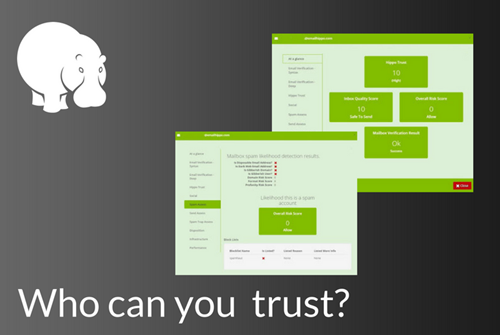Disclaimer: This article was originally published in December 2017 and refers to an older version of the Email Hippo trust score. We now have two different trust score models for our MORE and ASSESS products respectively. Find out more in our knowledge base - here.
What do the Email Hippo Trust Score results mean?

This article is for users of Email Hippo who are learning about the new dashboard tools and people who aren't using Email Hippo yet and are learning about the Trust Score.
The Email Hippo Trust Score is unique. It's shown as a simple score out of 10, calculated from results of 74 factors that we check about every email address. The detail about every factor is fed into an algorithm. We've developed the algorithm to take into account relationships between the factors, importance weightings and heuristics.
The algorithm is a window onto our IP, so we'll talk around it but won't publish the absolute detail.
Two simple examples of the Email Hippo Trust Score;
- an email that contains profanity and is listed with Spamhaus should not be trusted, so an Email Hippo Trust score will be 0
- an email address that is role based 'salesmanager@xyz.com' is not such a high quality as an email that contains a real name, so the role based address won't have such a high score as the real name email addresses
When do you see the Email Hippo Trust Score?
The Trust Score shows up in two places. On one-by-one email checks via the Email Hippo dashboard, and within the results available from the email verification API when it's used in any other environment.
From your dashboard, if you enter an email address to check, the results returned will show a score. By clicking each element of the results, it's possible to drill down into the email address and see up to 74 individual elements of results about it.
Here's what the score looks like on the dashboard; The results are for our support email address, which scores 10/10, with a Risk Score of 0 and a Mailbox Verification result of OK. What these four boxes are saying is 'yup, safe to send, email won't bounce, this individual is credible and trustworthy.'

Learn more about why email verification is essential for your business
How to read the Trust Score
There is an overall Trust Score and three sub-scores. The sub-scores are Quality (safe to send) Overall Risk and Mailbox Verification.
Within the 'At a glance' menu on the left hand side, results are grouped together. Clicking on any of the group titles results in greater detail being exposed in the right hand panel. The screen below shows information relating to the spam assessment for the email address. It includes results of checks for profanity, gibberish, dark web, disposable email address and spam listing with Spamhaus. the component part of this assessment is shown as a risk score - where 0 is very good and 8 is very bad.
The screen below shows the dashboard view of the detail within the 'Infrastructure' group. It includes detail about the email service provider, mail server location and the SMTP banner. Hopefully you can appreciate that the Trust Score is a simple way of displaying multiple pieces of information about every email address.

The Email Hippo Trust Score results within the More API
Away from the dashboard with its graphic interface, an Email Hippo Trust Score is also returned within the datapoints of the More API.
The API results are multi-dimensional, and it's possible to profile data to give a picture of results overtime / by comparison. Running a list through the API would give a user the data to group and report on characteristics of the list. Capturing results from single returns at point of entry (e.g. sign-up forms) will enable users to profile email address scores and model links with customer behaviour.
The Trust Score is displayed as a single result, so it's possible to use the score to profile data and enhance its value.
What are the benefits of Email Hippo Trust Score?
The scoring is valuable as it helps you make decisions about whether to send to email addresses. It also helps you plan more effective marketing campaigns and experiment with different segments on your marketing email list.
For example, you could mail all emails within two scores to see at what scores give you the best (and worst) open rates. Data brokers could use the score as a pricing tool or an indicator for a quality mark and guaranteed delivery rate.
The Email Hippo Trust Score is completely unique within the email validation industry. It's a reflection of the need for more information about email addresses, and a way for us to share our knowledge and experience in a way that's easily accessible and useful.
For more information about the results our More API returns, including references to the Trust Score;
*The Trust Score isn't part of our Core bulk email checking product. Lists uploaded and processed through the dashboard using our Core bulk email checking service will not include a Trust Score.







